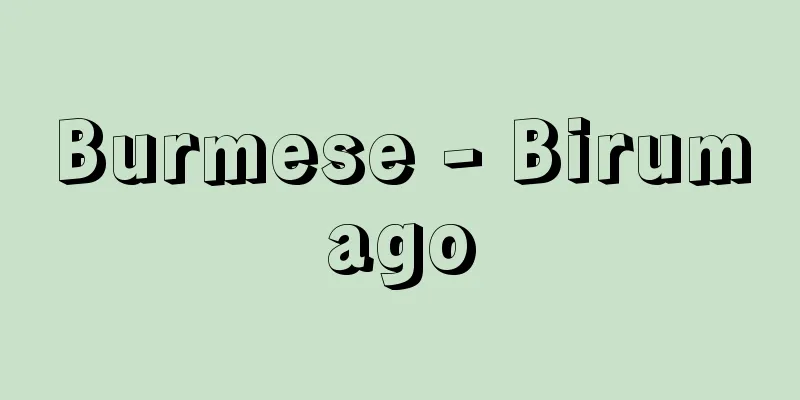Burmese - Birumago

|
The official language of Myanmar (Burma), written in the Burmese script and spoken by approximately 32 million people. [Tatsuo Nishida] Structural featuresThere are 34 consonants, 5 vowels (a, i, u, e, o) and 4 diphthongs (ai, au, ei, ou). It is a tonal language, and there are three contrasts: ca (chia) (low flat) "lotus", câ (high flat) "tiger", and cà-de (high descending) "fall". There are also ca (high flat) "ruby" and cai-te (high descending) "like". Most words are monosyllabic, but there are also many polysyllabic words. The word order is subject-object-verb, and nouns are accompanied by case particles. Adjectives follow nouns, but can also be placed before them with the addition of a particle. For example, "white horse" can be myîn byu "horse ← white" or phyu-de myîn "white → horse". Tense and other things are expressed by adding auxiliary verbs after the verb. "Go" is wa-de, "went" is wa-bi, "will go" is wa-me. Counter particles are used, and "a piece of paper" is arranged in the order of noun, counter, and counter particle, such as paper, one, sheet. Honorific expressions are also used. The vocabulary is rich in loanwords from Pali and Mon, which are considered elegant, and in recent years many English words have been added. Intransitive and transitive or causative verbs are also distinguished by the contrast between an aspirated and an aspirated sound at the beginning, such as cà-de "to fall" versus chà-de "to drop." [Tatsuo Nishida] dialectIt is divided into five major dialects: (1) Central dialect (Yangon, Mandalay), (2) Southwestern dialect (Arakan), (3) Southeast dialect (Taboi), (4) Eastern dialect (Intha), and (5) Western dialect (Yaw). Of these, (2) and (3) are important as they still preserve the old forms as colloquial speech. [Tatsuo Nishida] historyThe oldest inscription is the Myazedi inscription from 1112 (a four-sided stone pillar with almost identical text inscribed in Burmese, Pali, Mon, and Pyu), but research into the history from then until modern languages is possible through the many inscriptions made during the Pagan period and literary works (prose and verse) that appeared from the 14th century onwards, and while the main points have been clarified, research into vocabulary and grammar has not yet progressed sufficiently. A large amount of literature remains, including Buddhist scriptures and literary works recorded in Pesar (Bai-tara manuscripts) and Parabai (folded manuscripts). [Tatsuo Nishida] systemIt belongs to the Burmese family of the Burmese-Lolo group of the Tibeto-Burman language family, and is close to Mar (Lansu), Lashi (Lachi), and Atsi (Tsaiwa), which are found from northern Burma to Yunnan Province in China. It also shows regular correspondences with languages such as the Yi family, and Burmese plays a large role in Tibeto-Burman comparative linguistics. [Tatsuo Nishida] Source: Shogakukan Encyclopedia Nipponica About Encyclopedia Nipponica Information | Legend |
|
ミャンマー(ビルマ)の公用語。ビルマ文字で表記され、約3200万人の話し手がいる。 [西田龍雄] 構造特徴子音34、母音5(a, i, u, e, o)のほか二重母音4種(ai, au, ei, ou)がある。声調言語で、たとえばca(チヤー)(低平型)「蓮(はす)」、câ(高平型)「虎(とら)」、cà-de(高降型)「落ちる」の3種の対立があるほか、いわゆる入声(にっしょう)にあたるca(高平型)「ルビー」、cai-te(高降型)「好く」が認められる。単音節語を主体とするが、多音節語も多い。語順は主語・目的語・動詞の型をとり、名詞は格助詞を伴う。形容詞は名詞のあとにつくが、助詞を加えて前に置くこともできる。たとえば、「白い馬」は、myîn byu「馬←白」でもphyu-de myîn「白い→馬」でも可能である。時制などは、動詞のあとに助動詞をつけて表現する。「行く」wa-de、「行った」wa-bi、「行くだろう」wa-me。助数詞が使われ、「一枚の紙」は、紙・一・枚のように、名詞・数詞・助数詞の順に置かれる。敬語表現もある。語彙(ごい)には、パーリ語、モン語からの借用語が豊富で、雅語とみなされ、近年は英語が多く入っている。また、cà-de「落ちる」対chà-de「落とす」のように、自動詞と他動詞あるいは使役動詞とを、初頭の無気音と出気音の対立で弁別する手段も使われる。 [西田龍雄] 方言五大方言に大別される。〔1〕中央部方言(ヤンゴン、マンダレー)、〔2〕南西部方言(アラカン)、〔3〕南東部方言(タボイ)、〔4〕東部方言(インダー)、〔5〕西部方言(ヨー)。このうち〔2〕〔3〕は、古い形式をいまなお口語として保存していて重要である。 [西田龍雄] 歴史最古の碑文は、1112年のミャゼディー碑文(四面の石柱で、ほぼ同一の内容がビルマ語、パーリ語、モン語、ピュー語で刻まれている)であるが、それ以降現代語に至るまでの歴史の研究は、パガン時代につくられた多くの碑文や14世紀以降に出現する文学作品(散文・韻文)を通して可能であり、主要な点は判明しているが、語彙・文法の面でまだ十分な研究が進んでいない。ペーザー(貝多羅(バイタラ)文書)やパラバイ(折り畳み写本)に記録される仏教経典や文学書はじめ多量の文献が残されている。 [西田龍雄] 系統チベット・ビルマ語派のなかのビルマ・ロロ語群のビルマ語系に属し、ビルマ北部から中国雲南省に分布するマル語(浪速(ランス)語)、ラシ語(拉期(ラチ)語)、アツィ語(載瓦(ツアイワ)語)と近い。また、彝(イ)語系などの言語と規則的な対応を示していて、チベット・ビルマ比較言語学においてビルマ語の果たす役割は大きい。 [西田龍雄] 出典 小学館 日本大百科全書(ニッポニカ)日本大百科全書(ニッポニカ)について 情報 | 凡例 |
Recommend
Par value
The exchange rate between a currency and a common...
Siberian Husky (species)
A sled dog native to Siberia. Husky is a general t...
Eptesicus
...A general term for mammals belonging to the ge...
Azuma Nishikigai (Azuma Nishikigai) - Azuma Nishikigai (English name) Chlamy farreri nipponensis
A beautiful fan-shaped bivalve mollusk of the Pect...
Cowles, HC
…Studies on succession in the United States progr...
Willpower - Intention
Legally, the mental capacity to determine the mea...
Poggendorff, Johann Christian
Born: December 29, 1796 in Hamburg Died January 24...
Conchostraca
…The larvae hatch at the nauplius or metanauplius...
British Malaise
The phenomenon of stagnation seen in the UK after ...
Ganpishi paper
Washi paper is made from the bast fibers of the g...
Joint fusion surgery - kansetsu koteijutsu
This is a surgery to fix a joint in a good positi...
Rice exchange - beikokutorihikijo (English spelling)
An exchange for trading rice futures. Its purpose...
Mitre, Bartolomé
Born: June 26, 1821, Buenos Aires Died January 18,...
Livestock Inspection - Kachikushinsa
The process of determining the economic value of i...
Emphysematous cyst - emphysematous cyst
…These include the internal bullae, the subpleura...








![Shinshinotsu [village] - Shinshinotsu](/upload/images/67cbeaa8eaecb.webp)
